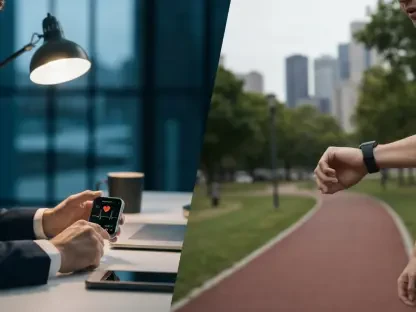Once upon a time, mobile phones were simply portable telecommunication devices. Initially bulky and expensive, they’ve undergone a rapid transformation over the years. From the flip phones of the late ’90s to the rise of the touchscreen smartphone in the early 21st century, mobile devices have integrated themselves deeply into our daily lives. Today, they are our calendars, cameras, maps, and personal assistants all rolled into one. With each passing year, these gadgets become faster, sleeker, and increasingly sophisticated, boasting an array of features that were once the stuff of science fiction.
While the term “smartphone” has been in use for more than a decade, we’re entering an era where the term “smart” may not do justice to the capabilities of these devices. What we carry in our pockets and hold in our hands is much closer to earning its “genius” device status. Thanks to cutting-edge technologies, smartphones are now becoming hyper-intelligent platforms that extend well beyond calling, texting, and even the capabilities offered by apps.
This blog post aims to shine a light on five technologies that are catalyzing this transition. We’ll delve deep into foldable screens, under-display cameras, and AI processors. Let’s explore these exciting advancements, and take a glimpse into a future where your mobile device is, quite literally, a pocket-sized genius.
Foldable Screens
Foldable screens represent a remarkable leap in display technology. Unlike traditional flat-panel displays, foldable screens use flexible OLED (Organic Light-Emitting Diode) or AMOLED (Active-Matrix Organic Light-Emitting Diode) technology. These materials can bend without breaking, allowing for a screen to be folded and unfolded thousands of times without damaging the display.
Why It’s a Game-Changer
What makes this technology truly game-changing is its ability to challenge the conventional form factor of mobile devices. For years, we’ve been confined to rigid, rectangular screens. Foldable screens open up new possibilities for device design, user interfaces, and applications. They mark a significant departure from the “black mirror” that we’ve grown accustomed to, setting the stage for a new generation of interactive and multifunctional devices.
Practical Applications
As intriguing as the technology behind foldable screens is, the real excitement lies in how it can improve our everyday digital experiences. In this section, we’ll explore the various ways foldable screens offer enhanced multitasking, increased screen real estate, and unparalleled convenience.
Multitasking Made Easy
One of the most practical applications of foldable screens is enhanced multitasking. With a larger, more adaptable screen, users can run multiple apps simultaneously in a more intuitive way. For example, you could watch a video on one half of the screen while scrolling through your emails on the other.
More Screen Real Estate
Foldable screens effectively double the screen real estate without making the device bulkier in your pocket. For instance, when unfolded, a 6.5-inch foldable phone could offer you a mini-tablet-sized display of up to 13 inches. This is especially beneficial for tasks like video editing, reading digital magazines, or working on spreadsheets, which are often difficult on smaller screens.
Convenience and Portability
While larger tablet devices offer increased screen real estate, they lack the portability of a mobile phone. Foldable screens offer the best of both worlds: a larger screen when you need it and a pocketable device when you don’t.
Pioneers in the Field
Several companies are vying to lead in the foldable screen market, but a few stand out for their innovation and successful product launches:
- Samsung: The Samsung Galaxy Z Fold and Galaxy Z Flip series have been praised for their build quality and seamless user experience. Samsung seems committed to refining this technology and has even incorporated it into other devices like tablets.
- Huawei: Known for its Mate X series, Huawei has managed to produce foldable screens that offer stunning visuals and a sturdy build. However, its reach has been somewhat limited due to trade restrictions.
- Microsoft: Though not exactly a smartphone, Microsoft’s Surface Duo features a dual-screen setup that mimics the foldable experience. It has opened up new avenues for productivity on mobile devices.
Upcoming Contenders
Companies like Google, Xiaomi, and Oppo have also teased their forays into the foldable screen market, promising new and exciting iterations of this transformative technology.
Foldable screens are ushering in a new era of mobile devices that promise to redefine how we interact with technology. With major companies investing heavily in research and development, it’s only a matter of time before foldable screens become a standard feature in the mobile landscape.
Under-Display Cameras
As we continue our journey through the technologies making our smartphones “genius” devices, we come to under-display cameras. This technology promises a leap forward in design and functionality, allowing for an unobstructed, full-screen display experience. Here’s how it works, its impact on user experience, and the challenges that lie ahead.
What are Under-Display Cameras?
Under-display cameras represent another innovative step in smartphone design. But what are they exactly, and how do they improve our devices? In this subsection, we’ll explore the technology behind under-display cameras and why they could become a staple feature in future mobile phones.
Explanation of Under-Display Camera Technology and Its Benefits
Under-display cameras utilize a specialized section of the screen that becomes transparent when the camera is activated. This allows the camera sensor to capture images without requiring a dedicated cutout or notch, thereby providing a seamless, full-screen experience. This design solves the aesthetic challenge of the “notch” or “punch-hole” that has been associated with many smartphones, making for a more immersive user experience.
User Experience
The concept of under-display cameras is undoubtedly fascinating from a technological standpoint, but how does it translate into a better user experience? In this part, we’ll look at how this technology affects your interactions with your device.
How Under-Display Cameras Improve User Experience
With an under-display camera, the screen estate is used to its fullest extent, eliminating distractions caused by camera notches or punch-holes. This offers a particularly significant advantage for tasks like video streaming, gaming, and video conferencing, where an unobstructed display enhances immersion and usability.
Challenges and Future Potential
While under-display cameras offer compelling advantages, no technology is without its hurdles. In this section, we delve into the current challenges facing under-display cameras and explore how they might be overcome in the near future.
The primary challenges for under-display cameras include reduced camera quality due to the overlaying screen and the complexity of manufacturing such intricate technology. However, with ongoing research and development, these obstacles are likely to be surmounted. Companies are already working on advanced algorithms to correct image quality, and manufacturing techniques are steadily improving.
AI Processors
As we navigate through the emerging technologies defining the next generation of smartphones, we encounter AI Processors—a cornerstone in transforming these devices from “smart” to “genius.” In this section, we will dissect how AI is becoming an indispensable component of mobile technology, its real-world applications, and the companies that are leading this exciting frontier.
The Rise of AI in Mobile Technology
AI is no longer the stuff of sci-fi movies; it’s a reality that’s seeping into various aspects of our lives, including our mobile devices. In this subsection, we’ll explore how AI has gone from being an optional feature to an integral part of the smartphone experience.
How AI Is Becoming an Integral Part of Mobile Phones
In recent years, mobile processors have begun to incorporate dedicated AI cores that handle machine learning tasks. These AI processors can perform a wide range of functions at impressive speeds, from recognizing objects and scenes in photos to optimizing battery life. This specialized hardware allows for quicker, more efficient AI operations, which, in turn, elevates the overall performance and capabilities of the device.
Real-World Uses
It’s one thing to talk about the power of AI processors, but how do they translate into practical benefits in our everyday lives? In this part of the section, we’ll examine the numerous ways AI impacts common tasks performed on our smartphones.
Examples of AI in Everyday Mobile Tasks
- Photography: AI processors enable advanced image recognition, helping your phone auto-select the best settings for different environments or subjects.
- Voice Recognition: Speech-to-text and virtual assistants like Siri and Google Assistant have become more accurate and responsive thanks to AI capabilities.
- Battery Management: AI algorithms can predict your usage patterns and optimize battery usage accordingly, extending the lifespan of your device.
- Personalization: From curating news feeds to suggesting music or movies, AI processors make your smartphone truly adaptive to your preferences.
Market Leaders
With AI processors becoming an industry standard, which companies are pushing the envelope in this domain? Here, we’ll highlight the organizations that are making significant strides in integrating AI into their devices.
Companies Incorporating AI Processors Effectively
- Apple: With its A-series chips that include a Neural Engine, Apple has been at the forefront of integrating AI into its iPhones.
- Qualcomm: Known for its Snapdragon processors, Qualcomm has been pioneering the inclusion of AI cores for a wide range of Android devices.
- Huawei: Huawei’s Kirin chipsets are also AI-capable, offering a range of machine learning features, especially in the realms of photography and battery management.
- Samsung: The Exynos series of processors by Samsung also includes dedicated AI cores, providing a wide array of AI features in both their flagship and mid-range phones.
As AI processors continue to evolve, we can expect them to further blur the lines between what is considered “smart” and what can truly be deemed “genius,” providing us with devices that are more in tune with our needs and preferences than ever before.
Final Thoughts
As we’ve journeyed through the landscapes of foldable screens, under-display cameras, AI processors, graphene batteries, and LiDAR sensors, it’s evident that each technology brings its own unique set of capabilities to the table. While they serve different purposes and solve various challenges, together they constitute a transformative force that is redefining the very essence of what a mobile device can be.
These five technologies are not just standalone features; they are the building blocks of an integrated, immersive, and intelligent mobile experience. Foldable screens offer us unprecedented flexibility and screen real estate. Under-display cameras give us unobstructed, full-screen displays. AI processors make our devices more intelligent and responsive.
The beauty of these technologies is not just in their individual capabilities, but in the synergy they create when combined. Imagine a future where your foldable phone is, equipped with an under-display camera, can identify objects you point at, and is powered by an AI processor. It lasts days on a single quick charge, and is capable of mapping your environment in real-time. This is not science fiction; it’s a future that’s being actively built today.









